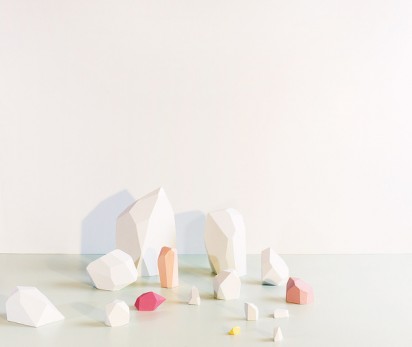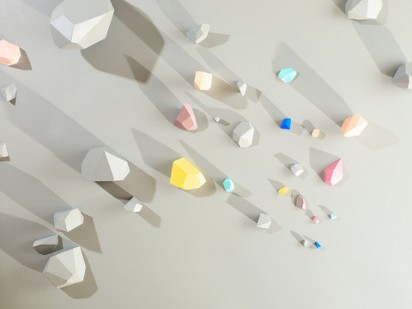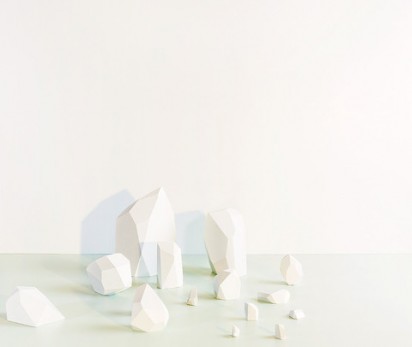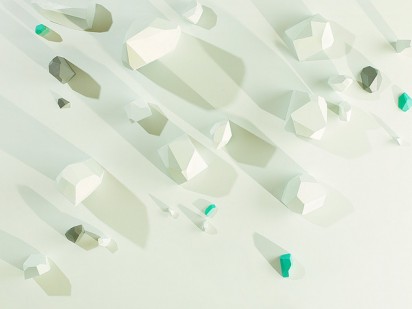
Whenever I’m interviewing an artist or designer about their work, I always make sure to hit the usual suspects: “Where do you find your inspiration?” or “What’s a typical day like for you?” or – perhaps the most telling of all – “Peanut butter or jelly?” Yet, by far, the prompt that elicits the most refreshing answer has always been the simplest of questions: “Why?”
Usually, an artist will reply with something deep and thought-provoking about nature or time or the meaning of life. Until, that is, Evonne Bellefluer answered…

“I don’t think art should be about communicating some ideology,” she writes in response to her latest work – a photographic collection of geometric blocks. “Art, like fashion, is meant to be enjoyed … something I look to to make me happy.”
It’s a happiness that she, like myself, never explored academically. But because the interest was there – and because that interest sparked happiness – she pursued it regardless. “I had a conversation with a friend the other day who suggested that my art didn’t belong in a gallery setting because it had nothing to say. I completely disagree,” she writes.

It’s a belief system that few hold, but many should. “Art for art’s sake,” a phrase coined in 19th century France, holds a deep history that has evolved into a simpler meaning in today’s society: art holds value, whether or not it has a specific agenda. Artists create because they love to create, just as I write because I love to write.
A professional chef might serve food to thousands of patrons in a busy restaurant, night after night. She might do so because she believes that quality food nourishes the soul, provides richness to conversation and fosters relationships. Or, she might simply love the creative outlet of mixing ingredients, experimenting with flavors, soiling her apron. Whether the intention lies in pushing an agenda vs. serving her own passions does not make her less-deserving of owning a restaurant and calling herself a chef. And it doesn’t change the taste of her food. Or does it?

Perhaps these tees exist simply because a designer noticed something beautiful in various typographic textures. But perhaps there’s a deeper purpose at work – perhaps these tees are meant for us to take pause and think about the future of our nation’s landscape, if only for a subconscious moment. Perhaps they’re meant to conjure up feelings of exploration and discovery. Perhaps, just maybe they were designed with intention.
And I think that’s what makes art art. It’s not about meaning or purpose or passion. It’s about intention. It’s about making a conscious decision to create something with your hands, your mind, your spirit. Whether the finished product holds an agenda doesn’t matter, because the agenda does not exist in the object. It exists within us.

And sure, Evonne Bellefluer’s work might not have a specific agenda. But she does, whether she realizes it or not.
(We all do.)
Image Credits: Evonne Bellefluer
Just for fun: Geometric paper sculptures, geometric handbags and geometric pinatas.


love this. LOVE.
@Danielle – Ah, thank you!
ditto that! I’ve always felt secretly shallow for wanting to make art just for fun. I feel empowered! And I LOVE the blocks.
@Laura – It’s funny how we often undermine our passions unless they’re contributing to an obvious meaning or serving a larger purpose, you know? Sometimes we need to remind ourselves to just DO. :)
Being immersed in the art world, reading artist statement after artist statement, many of them convoluted and nonsensical, it is incredibly refreshing to hear an artist say that she creates for the sake of making something enjoyable to look at. There is a place for work that has an intellectual or philosophical motive behind it and there is room for work created simply to be lovely to gaze upon. And the two aren’t necessarily mutually exclusive.
Loved this post. Every word of it!
@Artsy Forager – Amen! There’s a time and place for so many things, and it’s often more beautiful when balanced. And gosh, artist statements can be INCREDIBLY convoluted, yes? :)
i agree 100% i often would feel lame when creating works at school because i didn’t have a weighty (and lengthy) reason for doing what i was doing. thank you!
Ah, my friend Ingrid wrote a lovely post about how the joy of creating in itself is its own ideology. It’s beautiful!:
http://aestheticsofjoy.com/2013/03/joy-as-ideology/
Wonderful!
love it!
& here you are again – dishing out more diamonds. I love slow-go Design For Mankind.
Ah, you are sweet, Kirsty! Thank you!
Lovely.
I play jazz piano for fun and if I compare art making to music making, it all becomes clear to me. Musicians make music because they must. There is no agenda – it’s a drive that comes from within. Same with the impulse to create – it’s an itch to be scratched.
The agenda or meaning often comes from the viewer – we experience a piece of art and make our own meaning.
Amen!
Beautifully written and something that I struggle with all the time. Does art only have value because it has an overt message or ideology? We are encouraged to say what our work is about, but what if it is about a feeling, how do we express that. I personally make art because I have to rather than necessarily having a message to impart, I want people to feel something when they look at my work, to want to look because they think it’s beautiful. Somehow that has become an unfashionable thing to say. Thanks for sharing this.
refreshing and lovely to hear! thank you.
Once again, awesome post, thanks!
It makes me think about how I’m so passionate about my design work, however at the office I currently work in I feel myself trapped in office politics and all that b***. It’s such a buzz kill.
Time to get very proactive and further expand on the freelance to make the jump and leave the office stuff behind.
I love being a graphic designer and I love my work, time to leave the unhappy clutter behind.
@Alicia – I love this, Alicia! Go get ’em!
The art + design world needs more of these posts, Erin. Having come from an Art (capital A) school, I struggled with this the whole time I was there. You’re pushed to conceptualize ever more complex, arbitrary (usually, though not always) ‘meaning’ for my work. The one year that I tried to let go of that and really explore the techniques I was learning, I had the worst review of my 5 years there.
My work carries with it meaning of many different levels, but it isn’t convoluted, it isn’t complicated (though can be complex). Intention is a word that I use more than once in my little bio, and it’s a word that I live, and make, by.
Erin, you’re a gem.
@Brittany – Ah, I love (and simultaneously hate!) hearing this! Art school is wonderful for so many reasons, but it seems like you’re not alone in your experience. I think this sort of mindset applies to a lot of things in life – we’re pushed to stand out while blending in and “brand ourselves” into corners when, in reality, sometimes it’s just nice to make something because we want to. :)
All artists have many things to say. They speak through art. And just look at the decision-making involved in art.
Evonne Bellefluer is right that art isn’t always ideology-driven…but I think good art always says something (there is always meaning–every piece of art starts with nothing, just as every musician starts with silence–each mark or tool or even breath is a decision about what to put into the world).
And it also doesn’t always have to be overtly serious. The most meaningful work can also be the silliest or sweetest…that’s what I see in this artist’s work (a playfulness and appreciation for color).
@Hannah – I like that perspective, Hannah! And I think you bring up a great point – sometimes it’s not up to the artist to assign meaning. Sometimes we assign our own, as the viewer.
Thanks in support of sharing such a nice opinion, post is good, thats why i have read it entirely
Hi Erin! It’s so refreshing to read something like this. It can be exhausting to always be searching for the ‘what’ and the ‘why’ when it comes to something as ambiguous as the arts. Sometimes, it’s even hard to believe the explanations you receive because they feel so artificial and forced. I wish more artists were given the freedom to feel comfortable creating for its own sake.
@Katie – I agree 100%
Art for the sheer joy of art…I think that’s perfect.
Me too, Jan! :)
Thank you! After trying my hardest for years to sound so intellectual and deliberate when writing about my work, I’ve recently just gave up and started being honest and simple. Writing from the heart instead of the brainy brain. It liberates you as an artist, and it liberates your work from the confines of some calculated and pretentious purpose.
Also, these blocks look like some porcelain work I am currently doing. All things geometric and faceted are flying high in the collective creative conscious right now. Curious who made them, but the photos are amazing!
Love this, Janelle! Thank you for sharing! The blocks are a series by Evonne Bellefluer. :)
I love this post. Such a refreshing read on art.. and I just adore your writing. I agree- one of the biggest goals I have when creating art is just to make something beautiful and pretty!
Thank you so much, sweet Melanie!!!!
Those 3 years at uni on a so-called designer/maker course, where I was constantly questioned, where I had to have some sort of justification for what I was doing…pretty much destroyed all intuition and that playful enthusiasm I had. It’s been another 3 years and I’m beginning to get back what I lost. I’ve found that most of all the practicing designers/makers I’ve met or read about really do go on intuition, something beyond logic or intellectualizing…if it feels/looks right, then it is.
I’m so glad I’m not alone! Thanks for posting this, I love your blog;)
Ah, I love this story, Ann. I can absolutely relate even though I never went through art classes!
I love this. As a ‘maker of things’ I can totally relate. My mind simply will not let my hands be still, so I make things (and I bite my nails, and I tie my hair in knots and I do lots of other fidgety things that drive the Mister crazy).
I have always thought that it is the process of creating that is the most interesting part anyways. Sure, the final product might be beautiful and moving or incredibly useful, but largely, I think the product is only necessary because of the commerce aspect of creating. An object is only really interesting because you get to imagine how it fits into your life. It really has nothing to do with the person who made it (unless they’re famous or something) or the life of the object before you saw it. If you ask me, the process of making things, the figuring out and experimenting and the actual doing, is where it’s at. To watch someone make something up in their head and then figure out the best way to bring it to life with their bare hands and whatever tools and resources they have available is like magic. It’s just a shame we don’t focus more on the process and less on the end result…it could possibly change the way a lot of people live their lives.
I LOVE these thoughts, Miki – thank you for sharing!!! From one fidgety gal to another, cheers to you. ;)
From my own experience, when I see beautiful things, designed furniture, a well cooked meal, beautiful artwork—the most authentic gratitude I can show is to try to make it. The more moved I am, the more I want to recreate it. Not that I would simply copy it, nor ditch my artistic voice, but I will try to fold the simple pleasure I felt from the piece into my own work. Art for Art sake as a maker can also be a heartfelt thank you to what we see and experience in the world around us.
This is such a beautiful thought, Leah, thank you!